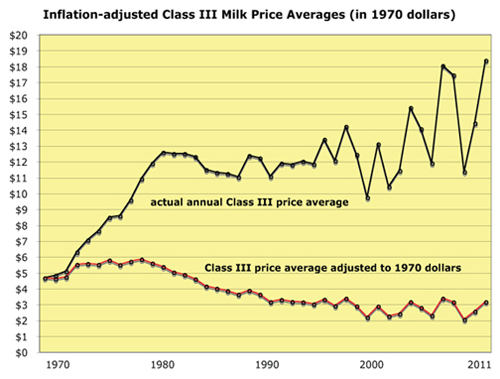How does $3 milk sound?
Ridiculous of course, yet the effective buying power that U.S. dairy producers have had for over 20 years has been even less when Class III prices are adjusted for inflation back to 1970 values. Here's something even more ridiculous: effective prices have occasionally been closer to $2.

Milk price buying power peaked at $5.83 in 1979, but it's been downhill ever since. Since 1990, the 1970-equivalent producer milk price has averaged just $2.91 per hundredweight. Some years it fared extremely badly, such as in 2000, 2002, and 2006. The financial meltdown year of 2009 was the worst so far.
Here's what we would see today if the price of things in 1970 had kept up with the rate of inflation, rather than exceeding it:
• U.S. No. 1 hay (about $34 per ton in 1970) would be $200 today.
• Corn (about $1 per bushel in 1970) would be $5.87 today.
• A gallon of regular gasoline (about 36 cents in 1970) would be $2.11 today.
• A 1st Class postage stamp (six cents in 1970) would be 35 cents today.
Of course, some prices have failed to keep up with inflation. One is incredibly frustrating to producers; others are a relief:
Ridiculous of course, yet the effective buying power that U.S. dairy producers have had for over 20 years has been even less when Class III prices are adjusted for inflation back to 1970 values. Here's something even more ridiculous: effective prices have occasionally been closer to $2.

Milk price buying power peaked at $5.83 in 1979, but it's been downhill ever since. Since 1990, the 1970-equivalent producer milk price has averaged just $2.91 per hundredweight. Some years it fared extremely badly, such as in 2000, 2002, and 2006. The financial meltdown year of 2009 was the worst so far.
Here's what we would see today if the price of things in 1970 had kept up with the rate of inflation, rather than exceeding it:
• U.S. No. 1 hay (about $34 per ton in 1970) would be $200 today.
• Corn (about $1 per bushel in 1970) would be $5.87 today.
• A gallon of regular gasoline (about 36 cents in 1970) would be $2.11 today.
• A 1st Class postage stamp (six cents in 1970) would be 35 cents today.
Of course, some prices have failed to keep up with inflation. One is incredibly frustrating to producers; others are a relief:
- Basic milk prices ($4.66 in 1970) should be $27.34 today.
- Cull cows (about 23 cents per pound in 1970) should be $1.35 per pound today.
- Top Holstein cows (about $575 in 1970) would be $3,374 today.
- A gallon of milk (about $1.15 in 1970) would be $6.75 today.
- A pound of round steak (about $1.30 in 1970) would be $7.63 today.
- If the federal minimum wage of $1.60 per hour had kept up with inflation, it would be $9.39 today instead of $7.25.








